Looking to slim down your waistline and feel more confident in your body this year? You’re not alone! In 2025, fitness has gone smarter, more efficient, and more personalized than ever. Whether you’re working out at home or hitting the gym, these waist slimming exercises will help you sculpt a tighter midsection and shed stubborn belly fat naturally.
Let’s explore the top 10 proven exercises for a slimmer waist—backed by fitness trends and core science in 2025.
1. Standing Oblique Crunches
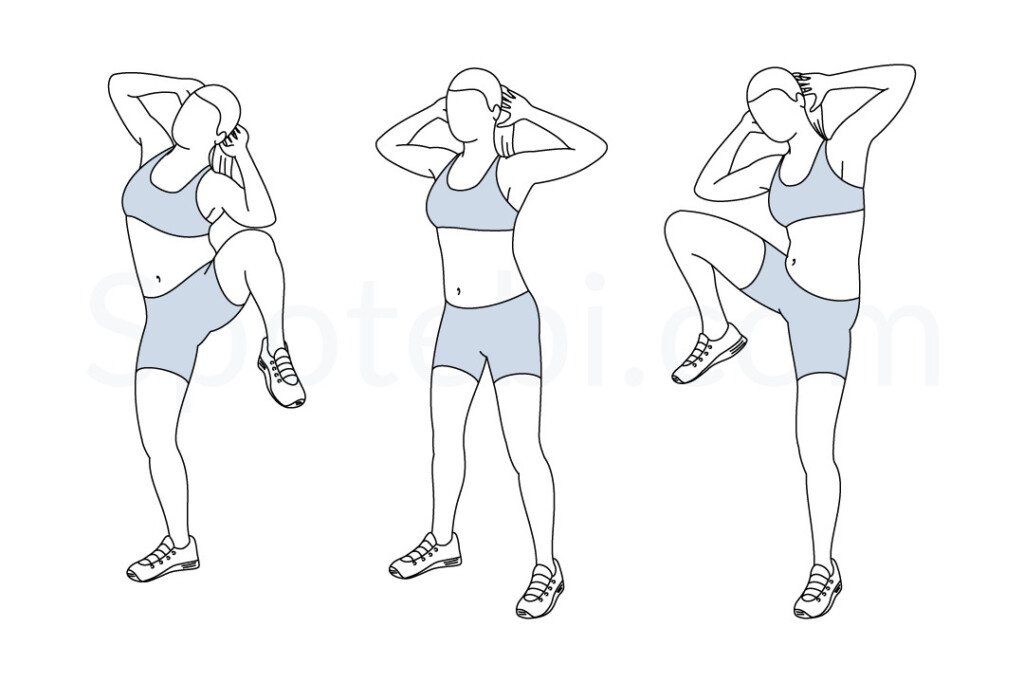
Why It Works: This is a perfect standing core move that targets the obliques and keeps your posture upright.
How to Do It:
- Stand tall with feet hip-width apart.
- Place your hands behind your head.
- Crunch to the left, bringing your left knee toward your left elbow.
- Return and switch sides.
Bonus: Great for people who dislike floor exercises and want to stay on their feet.
2. Russian Twists (with Smart Medicine Ball)
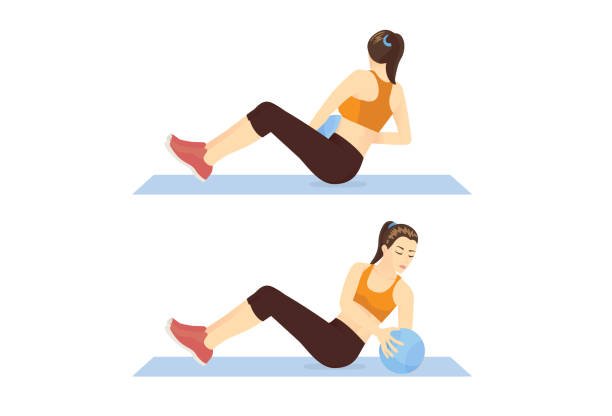
Targets: Obliques, upper abs, and lower abs.
How to Do It:
- Sit with knees bent, lean back slightly.
- Hold a medicine ball or weight.
- Twist your torso to the left, then right.
2025 Upgrade: Smart medicine balls now track your reps and resistance in real-time. Great for home fitness!
3. Plank Hip Dips
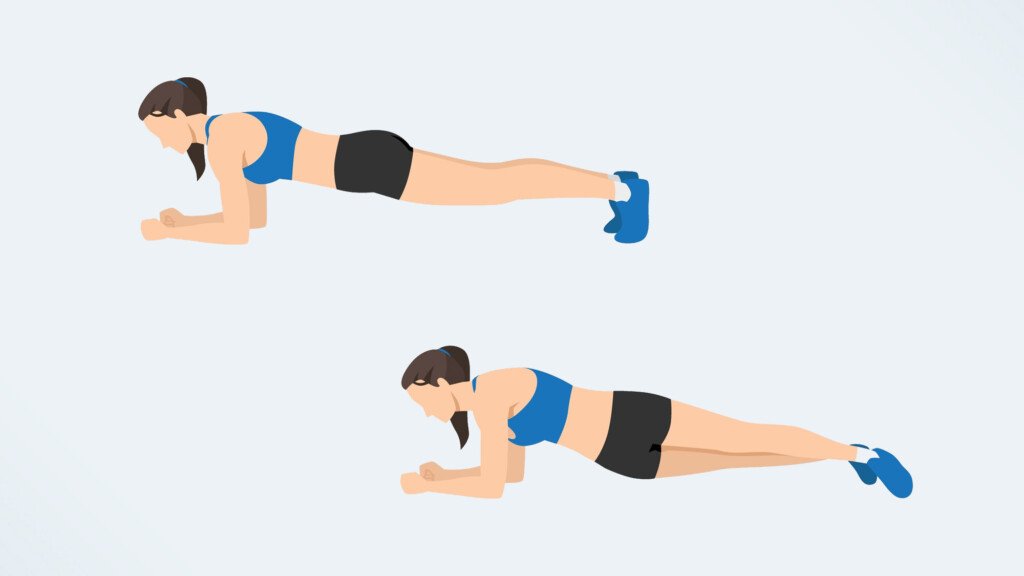
Why It Works: This core burner strengthens your entire abdominal wall with a special focus on waist definition.
How to Do It:
- Start in a forearm plank position.
- Slowly dip your hips to the right, then the left.
- Keep your core engaged throughout.
Tip: Try using wearable tech like Fitbit or WHOOP to monitor your core stability and calorie burn.
4. Pilates Side Leg Lifts
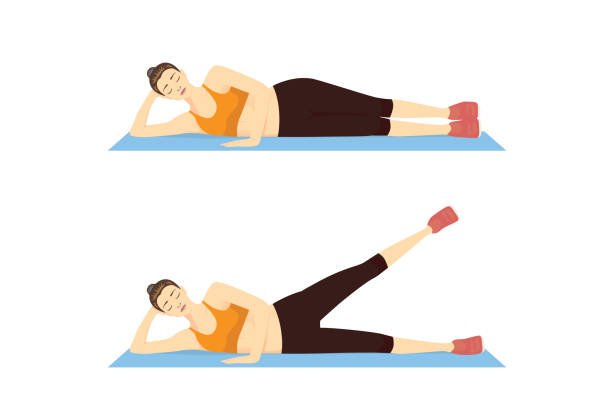
Why It Works: A classic move that tones the outer thighs and trims the waist through targeted side movement.
How to Do It:
- Lie on one side, supporting your head with your hand.
- Lift your top leg slowly and lower with control.
Pro Tip: Incorporate Pilates 2–3 times per week for long, lean muscle tone.
5. Bicycle Crunches
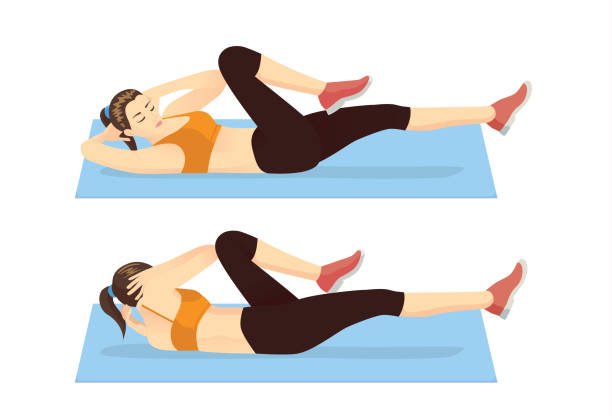
Why It Works: One of the most effective ab exercises, activating more muscle than traditional crunches.
How to Do It:
- Lie on your back, hands behind your head.
- Bring your opposite elbow to your knee in a cycling motion.
- Go slow to engage your core fully.
Tip: Focus on form over speed for maximum burn.
6. Smart Weighted Hula Hoop Workouts
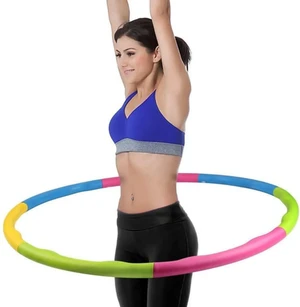
Why It Works: A fun, cardio-driven way to trim the waist while boosting your step count.
2025 Feature: Smart hoops track your spin count, time, and calorie burn.
How to Use:
- Stand tall, engage your core.
- Keep hoop in motion for 10–20 minutes daily.
Perfect For: People who want a fun, dance-like core routine.
7. Mountain Climbers
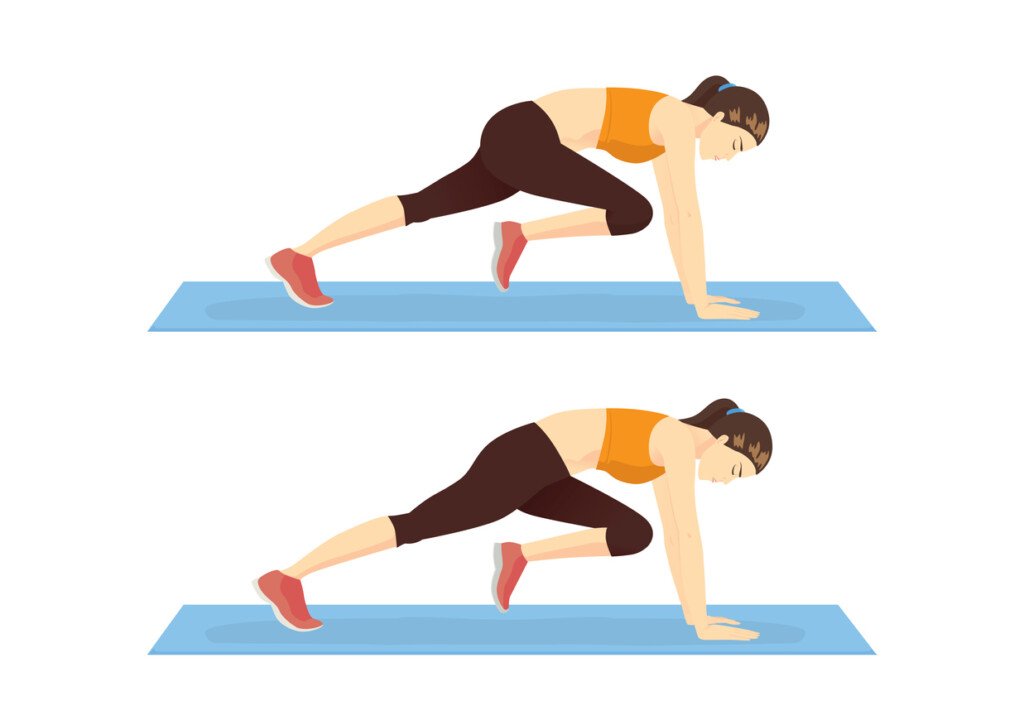
Why It Works: Combines core tightening with heart-pumping cardio for a double fat-burning effect.
How to Do It:
- Start in a high plank position.
- Drive one knee toward your chest, then alternate quickly.
Great For: Busy people—30 seconds of these equals major calorie burn.
8. V-Ups
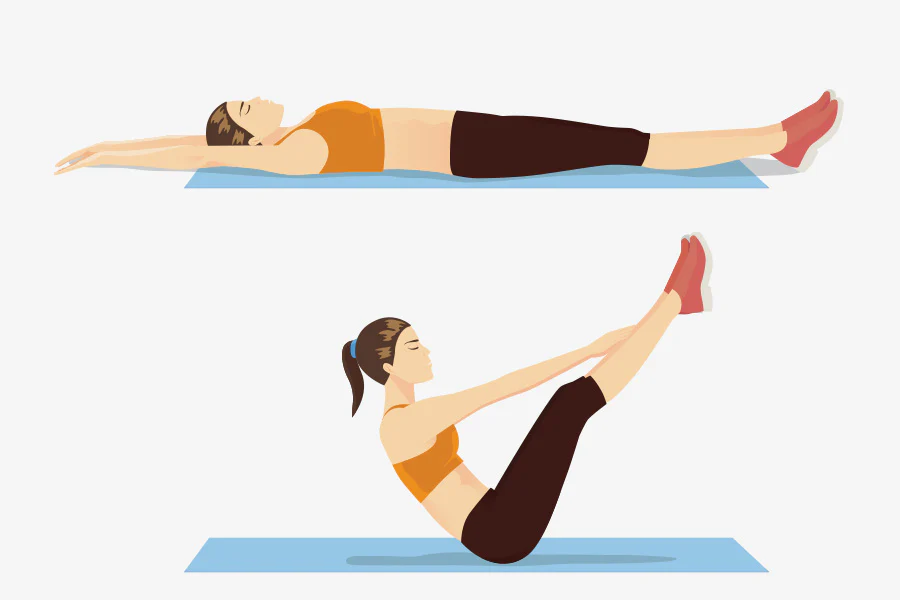
Targets: Entire core, including deep abdominal muscles.
How to Do It:
- Lie flat with arms extended overhead.
- Simultaneously raise your legs and upper body to form a “V”.
- Slowly lower back down.
Advanced Twist: Try balancing on a stability ball for added challenge.
9. Dead Bug Exercise with Resistance Band
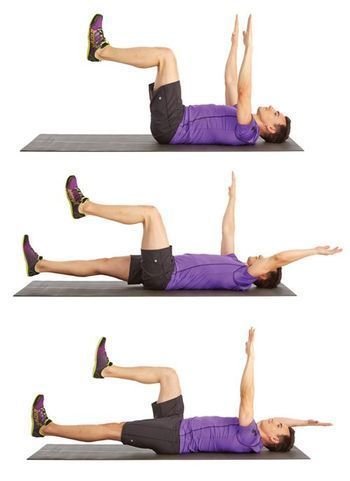
Why It Works: Strengthens the deepest core muscles (transverse abdominis) responsible for a tight waist.
How to Do It:
- Lie on your back, arms and knees raised.
- Extend one arm and the opposite leg, then return to start.
- Repeat on the other side.
Tip: Use a resistance band around your feet to increase the challenge.
10. HIIT Core Circuit (Fat Burning Combo)

Why It Works: Combines high-intensity cardio with targeted ab moves to torch belly fat and tone muscles.
Sample Circuit:
- 30 secs Plank
- 30 secs Jumping Jacks
- 30 secs Russian Twists
- 30 secs Bicycle Crunches
Rest 30 secs. Repeat x4.
Why It’s Hot in 2025: Shorter workouts, smarter results.
✅ Final Tips for a Slimmer Waist
- Consistency is key: Aim for 4–5 workouts per week.
- Fuel wisely: Eat clean with high-protein meals, fiber-rich veggies, and hydrate well.
- Track your progress: Use apps or wearables to stay motivated.
If you’re serious about trimming your waistline and building a stronger core, these waist slimming exercises are your go-to solution. They combine the best of traditional moves with modern fitness trends to help you achieve real, lasting results. Whether you’re just starting out or looking to level up your routine, consistency, clean eating, and targeted workouts will get you there. Make these waist slimming exercises a part of your weekly plan—and watch your waistline transform this year!
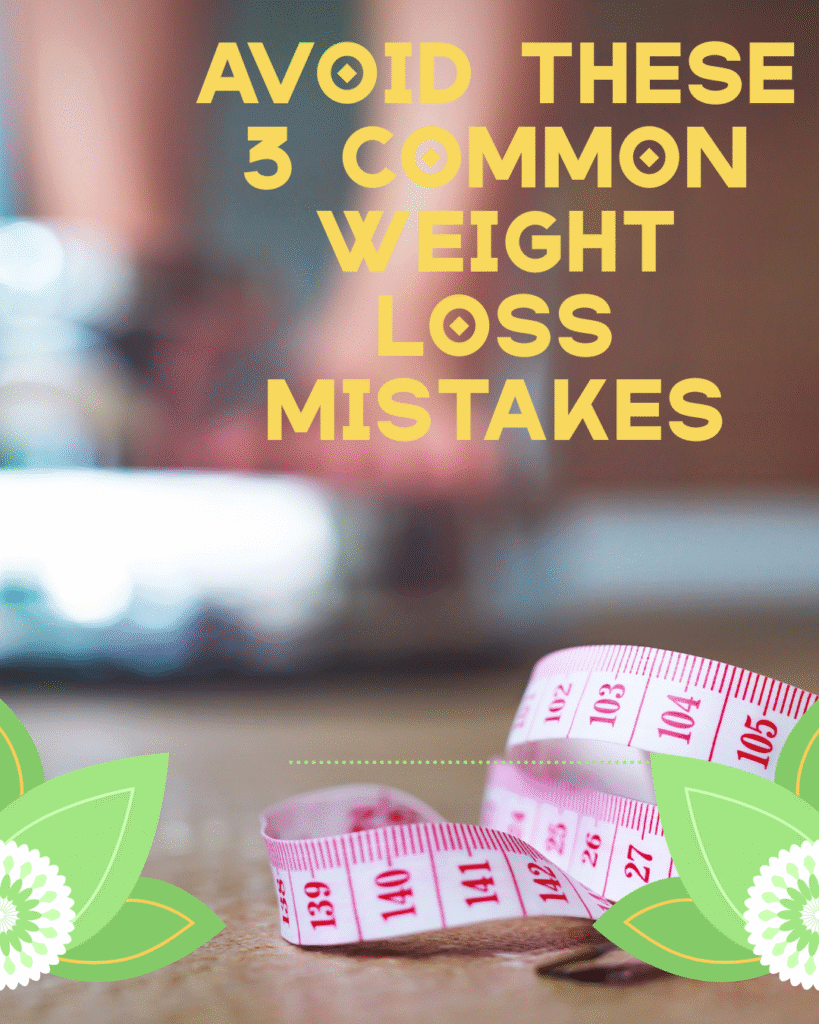
Losing weight is not just about eating less and moving more—it’s about doing it the right way. Unfortunately, many well-meaning people sabotage their own progress by falling into common traps. If you’ve been trying to lose weight but aren’t seeing the results you want, chances are you might be making one (or more) of these Common Weight Loss Mistakes.
Let’s break some of these Common Weight Loss Mistakes down and learn how to fix them—for good.
Mistake #1: Over-Restricting Calories
What you’re doing:
Slashing your daily calories to extreme lows, thinking the weight will melt off faster.
Why it’s a problem:
This might work for a few days or even weeks, but your body quickly adapts. Severe calorie restriction can:
- Slow down your metabolism
- Drain your energy
- Lead to irritability and mood swings
- Trigger intense cravings that result in binge eating
What to do instead:
Create a moderate calorie deficit—about 200–500 calories per day is enough for steady fat loss.
Focus on nourishing your body, not starving it.
Aim to lose 1–2 pounds (0.5–1 kg) per week for long-term success.
Mistake #2: Setting Unrealistic Goals and Following Unsustainable Plans
What you’re doing:
Starting extreme diets or intense workout regimens hoping to lose 10 pounds in a week.
Why it’s a problem:
Unrealistic goals lead to frustration and burnout. When the weight doesn’t come off fast enough, you might feel like a failure—even when you’re making progress.
What to do instead:
Set SMART goals: Specific, Measurable, Achievable, Relevant, and Time-bound.
Example: “I want to lose 10 pounds in 10 weeks by walking 30 minutes daily and eating more vegetables.”
Focus on building habits—not chasing perfection. A 15-minute walk, cooking one healthy meal, or saying “no” to sugar once a day all add up.
Mistake #3: Ignoring Emotional Eating & Skipping Strength Training
What you’re doing:
Eating when stressed, bored, or emotional. And when you do exercise, it’s all cardio, no strength.
Why it’s a problem:
- Emotional eating often flies under the radar, sabotaging your calorie control.
- Strength training is essential for preserving muscle mass. Without it, you lose muscle and fat—which slows your metabolism.
What to do instead:
Start tracking not just what you eat, but why. Keep a food/mood journal to spot emotional eating patterns.
Combine cardio with resistance training at least 2–3 times a week. This builds lean muscle, which burns more calories at rest.
Don’t be afraid of weights—bodyweight workouts, resistance bands, and dumbbells all count!
Final Tips for Sustainable Weight Loss
- Track wisely: Use apps or a food diary. Even “healthy” foods can be calorie-dense.
- Focus on consistency: Small daily actions beat huge, unsustainable efforts.
- Look beyond the scale: Measure inches, notice how your clothes fit, and track how strong and energized you feel.
In Summary:
| Mistake | Why It’s a Problem | How to Fix It |
|---|---|---|
| Extreme calorie cuts | Slows metabolism, triggers binges | Create a small, sustainable deficit |
| Unrealistic plans | Burnout, loss of motivation | Set SMART goals & focus on habits |
| Ignoring emotions & no lifting | Emotional eating & muscle loss | Track feelings & lift weights |
Final Thoughts
Weight loss isn’t a sprint—it’s a lifestyle change. Avoiding these Common Weight Loss Mistakes can help you make real, lasting progress without feeling deprived or overwhelmed. Focus on balance, self-awareness, and strength—both physically and mentally.
Ready to stop the cycle and finally make your results stick?

Understanding Weight Loss and Exercise
Weight loss is fundamentally based on the principle of calorie deficit, which occurs when an individual expends more calories than they consume. When engaging in a calorie deficit, the body is compelled to utilize its stored fat as a source of energy, which is where exercise plays a pivotal role. The best exercise to lose weight effectively aids in both creating and maintaining this calorie deficit through diverse physical activities that elevate energy expenditure.
Exercise is integral in enhancing metabolism, the complex biochemical process responsible for converting food into energy. Regular physical activity increases the basal metabolic rate (BMR), meaning that your body burns more calories even at rest. This boost is crucial for those aiming to shed pounds, as higher energy expenditure during and post-exercise leads to increased fat burning. Furthermore, incorporating various forms of exercise, such as aerobic, strength training, and flexibility workouts, can maximize weight loss benefits.
Beyond caloric burn, the physical benefits of regular exercise extend to improved cardiovascular health, muscle toning, and increased stamina. Engaging in activities such as running, cycling, strength training, or group classes not only contributes to fat loss but also encourages lean muscle development, which can further enhance metabolic rates. Consequently, individuals often experience higher energy levels and a greater capacity to perform daily tasks more efficiently.
Additionally, the mental benefits associated with exercise cannot be overlooked. Participating in physical activity has been shown to reduce stress levels, combat anxiety, and elevate mood. The release of endorphins and other neurotransmitters during exercise fosters a sense of well-being, which can enhance motivation and adherence to a weight loss regimen. In this way, embracing an active lifestyle not only contributes to weight loss but also facilitates holistic health improvements.
Cardio Exercises for Weight Loss
Cardiovascular exercises play a crucial role in any effective weight loss program, providing numerous options that cater to different preferences and fitness levels. Among the best exercises to lose weight, running is often regarded as one of the most efficient methods. It elevates the heart rate, burns significant calories, and can be easily modified to suit both beginners and seasoned athletes. For individuals just starting, incorporating intervals of walking can gradually build endurance while maintaining motivation.
Cycling is another excellent cardiovascular option, whether performed outdoors or on a stationary bike. It provides a low-impact alternative that minimizes stress on the joints while still facilitating substantial calorie expenditure. For optimal results, aim for at least 30 minutes of cycling, incorporating different resistance levels to challenge yourself and increase intensity.
Swimming stands out as a full-body workout that strikes a balance between calorie burn and joint protection. By utilizing various strokes, swimmers engage multiple muscle groups, enhancing strength and flexibility. It is advisable to swim continuously for at least 20 to 30 minutes, as this helps maintain an elevated heart rate, maximizing calorie burn.
High-Intensity Interval Training (HIIT) has gained popularity in recent years for its effectiveness and efficiency. By alternating between short bursts of intense activity and recovery periods, HIIT can yield significant weight loss results in minimal time. These workouts can often be completed within 20 to 30 minutes, making it easier to fit into a busy schedule.
To prevent burnout and maintain motivation while engaging in cardio exercises, creating a balanced routine is essential. Consider rotating between different activities such as running, cycling, swimming, and HIIT. This approach not only keeps workouts fresh but also targets various muscle groups for improved overall fitness. By committing to a structured cardio regimen, individuals can significantly enhance their efforts in achieving their weight loss goals.
Strength Training for Fat Loss
Strength training plays a crucial role in any weight loss journey, especially when aiming to shed excess fat. The process of building muscle not only improves overall strength but significantly boosts the resting metabolic rate. This increase means that the body burns more calories even while at rest, thus accelerating fat loss over time. Incorporating strength training into one’s fitness routine can be one of the best exercises to lose weight effectively, as it helps in creating a leaner physique.
Effective strength training exercises encompass a variety of options. Weight lifting is perhaps the most recognized form, involving the use of dumbbells, barbells, or machines to target particular muscle groups. Resistance band workouts are another excellent option, offering versatility and convenience. They provide resistance while being lightweight and portable, making them suitable for home workouts or while traveling. Bodyweight exercises, such as push-ups, squats, and lunges, also serve as an effective means to build muscle without the need for any equipment.
To fully benefit from strength training, it is vital to incorporate it into a weekly routine wisely. Ideally, individuals should engage in strength training exercises at least two to three times a week. Each session can focus on different muscle groups, ensuring that all areas are adequately targeted. Moreover, rest and recovery are integral components of physical training; the body needs time to repair and grow stronger. Adequate rest days should be factored into the regimen to prevent overtraining and allow for optimal muscle recovery.
In conclusion, strength training is indispensable for those wanting to achieve effective fat loss. By building muscle mass, individuals can increase their metabolic rate, allowing for enhanced weight loss benefits. Incorporating various exercises and ensuring proper rest will yield the most favorable results in a successful weight loss journey.
Creating a Sustainable Exercise Plan
Developing a sustainable exercise plan is crucial for anyone aiming to achieve their weight loss goals effectively. The foundation of this plan begins with realistic goal setting. It’s essential to identify specific, measurable, achievable, relevant, and time-bound (SMART) objectives. For instance, rather than stating, “I want to lose weight,” consider making it more concrete by setting a goal to “lose 5 pounds in 8 weeks.” This approach instills a sense of purpose and direction in your fitness journey.
Consistency is a key element in any successful exercise regimen. Engaging in physical activity regularly not only enhances the effectiveness of weight loss efforts but also helps to turn exercise into a habit. Aim to schedule workouts at times that fit seamlessly into your daily routine. This might involve morning sessions, lunchtime workouts, or evening exercises, depending on your lifestyle. Making a commitment to exercise a few times a week will significantly impact your progress in losing weight.
Tracking progress is another vital component of a sustainable exercise plan. Utilize a fitness app or a simple journal to log your workouts, noting improvements in endurance, strength, and overall well-being. Keeping track of your milestones creates a sense of achievement and helps you stay motivated. To avoid monotony, incorporate a variety of workouts into your routine. Mixing aerobic activities like running or cycling with strength training can keep your regimen fresh and enjoyable.
As you advance, remember to adapt your plan. Adjusting your goals and exercise intensity in response to your improvements will foster a continual challenge, enabling effective weight management. Additionally, combine your exercise efforts with healthy eating habits. Nourishing your body with nutritious foods will not only support your physical activity but also enhance your overall weight loss results. In conclusion, a well-structured and adaptable exercise plan, coupled with mindful eating, lays the foundation for sustainable weight loss. You could also buy some amazon products to help forster your weight loss journey.
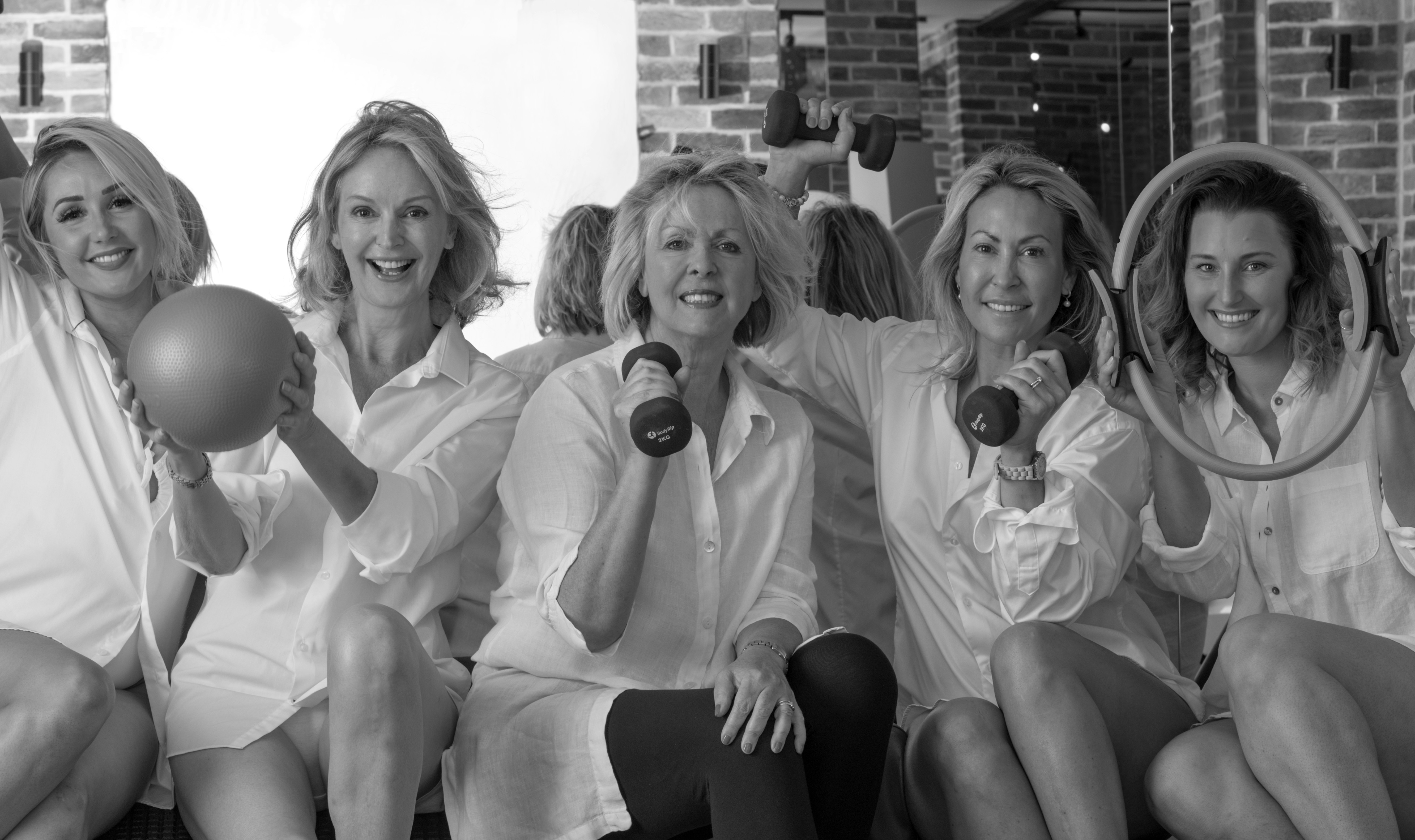
Understanding the Importance of Health and Wellness for Women
The health and wellness of women are critical components that warrant comprehensive attention, given the unique challenges and experiences they encounter at different stages of life. Biological, social, and psychological factors intertwine, influencing physical and mental health outcomes. From adolescence through menopause and into elderly care, women face distinct health issues, such as reproductive health concerns, hormonal fluctuations, and a greater propensity for certain chronic conditions like osteoporosis and heart disease. Thus, targeted health and wellness programs tailored for women are essential for addressing these unique needs.
Research indicates significant gender differences in health outcomes, emphasizing the need for gender-specific insights in health policies and programs. For instance, statistics suggest that women are more likely than men to experience anxiety and depression, impacting their overall wellness and quality of life. By understanding these disparities, health professionals can design and implement effective wellness initiatives that not only promote physical health but also support mental and emotional well-being.
Moreover, comprehensive health and wellness programs can lead to improved life quality through preventive care education and resources, empowering women to take charge of their health. These initiatives can include workshops, community support groups, and access to reliable health resources, promoting overall well-being. An example is the increasing recognition of maternal mental health, which underscores the necessity of providing adequate support systems for women during and after pregnancy.
In sum, addressing the multifaceted health and wellness needs of women through specialized programs is not only a matter of equity but also a crucial step toward enhancing the overall health of communities. By acknowledging and addressing specific health challenges and vulnerabilities, society can foster a healthier, more resilient female population, ensuring they thrive through each life stage.
Components of Effective Health and Wellness Programs for Women
Effective health and wellness programs for women encompass a variety of key components that address their unique health needs and challenges. One critical aspect is nutritional guidance, which focuses on educating women about well-balanced diets tailored to hormonal changes and lifestyle needs. Programs that offer personalized meal plans or workshops led by nutritionists help empower women to make informed dietary choices, thereby enhancing their overall health.
Physical activity is another vital component. Health and wellness programs that incorporate fitness routines suitable for different age groups and fitness levels foster an inclusive environment. Initiatives such as group classes, individual training sessions, or outdoor activities allow women to engage with exercise in ways that boost their confidence and motivation. These programs not only focus on physical strength but also promote cardiovascular health and flexibility.
Mental health support is equally essential in health and wellness frameworks. Programs that feature counseling services, mindfulness training, and stress management workshops address emotional well-being, enabling women to navigate life’s pressures effectively. Mental health resources can contribute to improved self-esteem and decreased anxiety levels, emphasizing the importance of a holistic approach.
Education regarding women’s health issues, including reproductive health, menopause, and chronic diseases, is crucial. Workshops and seminars that provide information on these topics empower women with knowledge, ensuring they can make proactive health decisions. Furthermore, community support plays a significant role in the success of these programs. Peer support groups create a sense of belonging and shared experiences, enhancing the overall effectiveness by allowing women to connect and learn from one another.
Finally, a personalized approach to health and wellness programs is essential. Tailoring services to meet individual requirements helps cater to diverse backgrounds and lifestyles. An example of an effective program is the “Wellness for Women” initiative, which integrates all these components. By providing practical resources and supportive environments, such programs are instrumental in promoting the health and wellness of women.
Success Stories: Women Who Transformed Their Lives Through Wellness Programs
The impact of health and wellness programs extends beyond mere physical transformation; it resonates deeply with personal empowerment and holistic development. Numerous women have embarked on journeys through such initiatives, overcoming various obstacles while cultivating healthier lifestyles. One such inspiring story is that of Maria, a 36-year-old mother of two, who joined a local wellness program in search of better health and vitality. Initially, Maria struggled with self-doubt and the demands of motherhood, feeling overwhelmed and fatigued. However, through the support of a nurturing community and structured resources, she learned to prioritize her physical health.
Maria engaged in group fitness classes and nutrition workshops, discovering an untapped passion for exercise and healthy cooking. As she gradually embraced these changes, she reported not only substantial weight loss but also increased energy levels and improved mood. Her journey underscores the transformative potential of wellness programs, illustrating how access to knowledge and community support can foster substantial lifestyle shifts.
Another narrative worth highlighting is that of Amina, a young entrepreneur who faced significant stress and anxiety due to her demanding career. Seeking a solution, she participated in a health and wellness program focused on mental well-being and stress management. Through mindfulness workshops and guided meditation sessions, Amina transformed her coping mechanisms. She developed tools to manage her stress effectively and established a work-life balance that had previously eluded her. Within months, Amina felt rejuvenated, with heightened productivity and a renewed zest for both her professional and personal life.
These testimonials illustrate that health and wellness programs serve as catalysts for profound life changes. By addressing various aspects of well-being, participants emerge equipped not only with physical improvements but also with enhanced mental resilience and emotional stability. Their stories reflect the strength and determination of women who have embraced wellness, inspiring others to embark on similar journeys towards healthier, more fulfilling lives.
How to Choose the Right Health and Wellness Program for You
Selecting the appropriate health and wellness program is a critical decision that requires careful consideration of various factors. To begin, personal goals should be clearly defined. Determine whether your primary aim is to lose weight, increase physical fitness, enhance mental clarity, or improve emotional well-being. A program designed specifically for these objectives will offer the best chance for success. Furthermore, interests and preferences play a significant role in choosing the right program. Engaging in activities that you enjoy, such as yoga, Pilates, or dance classes, can significantly enhance motivation and commitment to the program.
It is essential to consider your lifestyle when evaluating various health and wellness programs. Consider time constraints, obligations, and your ability to participate in specific activities. Programs that align with your daily routine and offer flexibility often yield better results. Additionally, inclusivity and diversity should be emphasized when selecting a program. A supportive environment that acknowledges and embraces differences among participants can foster a positive experience, enhancing engagement and outcomes for participants from various backgrounds.
Seeking out resources to find reliable health and wellness programs within your local community can further aid in making an informed choice. Local gyms, community centers, and online platforms offer workshops, seminars, and classes focusing on women’s health. Websites and social media groups also provide valuable insights and reviews regarding program effectiveness, as well as the experiences of other participants. By leveraging these resources, women can find programs that not only cater to their specific health and wellness needs but also promote inclusivity, ensuring that they feel welcomed and empowered in their journey towards improved well-being.

Introduction to Health and Wellness
Health and wellness encompass a holistic approach to the physical, mental, and emotional well-being of individuals. In a rapidly changing world, where stress and lifestyle choices significantly impact health, maintaining a balanced lifestyle has never been more crucial. This concept extends beyond the absence of illness, focusing instead on a comprehensive state of well-being that promotes vitality and quality of life.
In recent years, there has been a noticeable increase in health-conscious consumers who prioritize their well-being and seek products that support this lifestyle. Factors such as rising healthcare costs, increased awareness of chronic diseases, and the influence of social media have motivated individuals to become proactive about their health. This growing trend has led many to invest in various health and wellness products, which range from nutritional supplements to fitness equipment and mental health resources.
Amazon has recognized this demand and emerged as a leading platform for health and wellness products. Offering an extensive selection, the online marketplace provides consumers with the convenience of purchasing everything they need to support their healthy lifestyles from the comfort of their homes. From vitamins and supplements to organic food options, fitness gear, and self-care items, Amazon serves as a one-stop shop for health enthusiasts. The ease of access and variety available on the platform allows consumers to explore new products and find tailored solutions that align with their health and wellness goals.
As the importance of health and wellness continues to resonate within society, the need for reliable products and information has surged. Understanding the landscape of health-focused commodities available on Amazon is essential for anyone keen on improving their quality of life. This guide aims to provide valuable insights into the diverse categories of health and wellness products, empowering consumers to make informed choices regarding their health journey.
Top Categories of Health and Wellness Products
Amazon has emerged as a leading marketplace for health and wellness products, offering an extensive selection that caters to various consumer needs. In exploring the top categories available, it is evident that each contributes uniquely to individual well-being and overall lifestyle enhancement.
One prominent category is dietary supplements, which include vitamins, minerals, and specialty formulations designed to support different health goals. These products serve diverse purposes, such as enhancing immune function, promoting heart health, or assisting in weight management. Popular brands like Garden of Life, Nature’s Way, and Optimum Nutrition have cemented their presence in this category, emphasizing quality and efficacy.
Fitness equipment also plays a vital role in the realm of health and wellness. From cardio machines such as treadmills and stationary bikes to strength training devices like dumbbells and resistance bands, these products facilitate a wide range of physical activities. Brands like Bowflex, Peloton, and TRX are well-known for their innovative offerings that cater to both novice and advanced fitness enthusiasts, encouraging an active lifestyle while empowering individuals to meet their fitness goals.
Additionally, personal care products, including skincare and grooming items, contribute significantly to the health and wellness sector. These products, which encompass organic beauty creams, essential oils, and natural hygiene essentials, focus on nourishing the body and enhancing self-care routines. Brands such as Burt’s Bees, Neutrogena, and The Body Shop stand out in this space, promoting holistic well-being through their offerings.
Lastly, mental health resources, encompassing stress-relief aids, therapy tools, and mindfulness materials, are increasingly recognized as vital components of health and wellness. Products like meditation guides, journals, and aromatherapy diffusers aid individuals in finding balance and mental tranquility. Awareness of this category is rapidly growing, with numerous brands emerging to provide resources that promote mental well-being.
Buying Guide: What to Look for in Health and Wellness Products
When navigating the vast marketplace of health and wellness products on Amazon, it is crucial to make informed choices that align with personal needs and preferences. The first aspect to consider is ingredient transparency. Buyers should carefully review product labels to understand what is inside. Brands that disclose their ingredients demonstrate commitment to customer health, allowing for better-informed decisions based on individual dietary restrictions or preferences.
Another critical factor is product certifications. Look for products that are labeled as organic, non-GMO, or GMP (Good Manufacturing Practices) certified. These certifications not only signify adherence to quality standards but also assure consumers of the safety and efficacy of the products. This is particularly important in the health and wellness sector, where trust in product sourcing and manufacturing processes is paramount.
Customer reviews provide valuable insights into the real-world effectiveness of health and wellness products. Amazon offers a platform where users can share their experiences, helping prospective buyers gauge products’ reliability and effectiveness. When reading reviews, consider the overall rating but also pay attention to common themes in the comments, as these can shed light on both the strengths and weaknesses of the product.
Pricing is another important consideration. While it is tempting to opt for the cheapest option, it is essential to evaluate the cost against quality and effectiveness. Some reputable brands may be priced higher due to superior ingredients and manufacturing practices. Therefore, be wary of products that seem too good to be true, as they may compromise quality for affordability.
Lastly, familiarize yourself with the return policies associated with the products. A favorable return policy ensures that, should the product not meet expectations, consumers can easily rectify the situation. By taking the time to consider these factors, buyers can navigate Amazon’s health and wellness offerings more effectively and confidently.
Customer Favorites: Top-Rated Health and Wellness Products on Amazon
When it comes to health and wellness, the plethora of products available on Amazon can be overwhelming. However, customer reviews and satisfaction ratings can serve as a guiding light in navigating this extensive marketplace. Today, we will highlight some of the most recommended health and wellness products that have garnered positive feedback from fellow consumers, providing you with insights into what truly works.
One standout category is dietary supplements. Among these, multivitamins and probiotics have received high praise for their ability to support overall health. For instance, a leading brand of multivitamins boasts thousands of positive reviews, praising its comprehensive formulation that caters to a diverse range of nutritional needs. Customers often report increased energy levels and improved immune function after regular use.
Fitness enthusiasts frequently turn to resistance bands and yoga mats, both of which have seen significant popularity on Amazon. One particular yoga mat has emerged as a top favorite due to its durability and slip-resistant surface, making it an ideal choice for both beginners and seasoned practitioners. Reviews often highlight how the mat enhances exercise routines, contributing to improved flexibility and stress relief.
In addition to supplements and fitness gear, essential oils have carved out a niche within the health and wellness industry. Many users praise their calming effects, which can promote relaxation and mental clarity. A popular diffuser, known for its sleek design and effectiveness, receives accolades for transforming everyday spaces into serene sanctuaries.
The success stories tied to these products are abundant, with many customers sharing transformative experiences regarding their health journeys. Whether it is achieving fitness goals or enhancing general well-being, these products have proven their worth in the ever-evolving landscape of health and wellness. Customers find assurance in investing in these favorites, turning to them for reliable support in maintaining their healthy lifestyles.
Understanding Vaccinations

Vaccinations, also known as immunizations, are medical interventions designed to stimulate the immune system to develop protection against specific infectious diseases. The primary purpose of vaccinations is to prepare the body to fight off pathogens, such as viruses and bacteria, without causing the diseases they aim to prevent. By introducing a harmless component or a weakened form of the pathogen into the body, vaccinations trigger an immune response that results in the production of antibodies. This response equips the immune system to recognize and combat the actual disease-causing agent upon exposure in the future.
There are several types of vaccines, including inactivated or killed vaccines, live attenuated vaccines, subunit vaccines, and messenger RNA (mRNA) vaccines. Inactivated vaccines contain pathogens that have been killed or inactivated, while live attenuated vaccines consist of live pathogens that are weakened so they do not cause illness. Subunit vaccines include only parts of the pathogen that provoke an immune response, and mRNA vaccines use genetic material to instruct cells to produce a harmless piece of the virus, stimulating an immune reaction. The variety of vaccines allows for tailored approaches in immunization, catering to different diseases and populations.
The importance of vaccinations in public health cannot be overstated. They have played a critical role in reducing the prevalence of infectious diseases, leading to lower morbidity and mortality rates across populations. Vaccines contribute to herd immunity, whereby a significant portion of the population is immune, protecting those who are unvaccinated or immunocompromised. Despite their undeniable benefits, misconceptions about vaccinations persist. Some individuals question their safety and efficacy, often relating these concerns to potential side effects, including the fear of weight gain following vaccination. Addressing these concerns with accurate information is vital for improving public confidence in vaccine programs.
Exploring Links Between Vaccinations and Weight Gain
The relationship between vaccinations and weight gain has garnered attention in both the scientific community and general public discourse. While vaccines are essential in preventing infectious diseases, emerging discussions have pondered whether they might inadvertently affect metabolic processes, appetite regulation, and overall body composition. Understanding this connection requires a nuanced review of existing studies and anecdotal evidence.
Research examining the impact of vaccinations on weight has yielded mixed results. Some studies indicate that certain vaccines may influence metabolic pathways, potentially altering how the body processes nutrients and regulates fat storage. For instance, the introduction of specific antigens can invoke immune responses that, for some individuals, might inadvertently lead to changes in appetite or energy expenditure. However, the evidence supporting a direct causal relationship between vaccinations and significant weight gain remains limited and largely inconclusive.
Variability in individual responses to vaccines can complicate this issue. Factors such as genetics, pre-existing health conditions, and environmental influences can result in diverse outcomes following vaccination. For some people, weight management may be affected due to stress related to vaccination or changes in physical activity levels post-inoculation. Although anecdotes exist, they often lack robust scientific backing, making it vital to approach such claims with scrutiny.
Moreover, the psychological impact of vaccination—like anxiety about possible side effects—may inadvertently alter eating behaviors, contributing to weight fluctuations in certain individuals. The interplay between mental well-being and physical health underlines the complexity of this topic. Overall, while there are hypotheses regarding the effects of vaccinations on weight, especially concerning metabolic activity, more research is necessary to draw definitive conclusions. As this field evolves, understanding the myriad factors influencing individual responses will be crucial in deciphering the potential links between vaccinations and weight gain.
Expert Opinions and Research Findings
The relationship between vaccinations and weight gain has garnered attention among health professionals and researchers, sparking discussions that delve into the nuances of immunization impacts on overall health. Recent studies have sought to explore this connection, with varying conclusions regarding the potential for vaccinations to influence body weight. While some individuals express concerns about vaccinations leading to unintended weight gain, the consensus within the medical community tends to emphasize the safety and importance of vaccines in preventing diseases.
Health organizations, including the World Health Organization (WHO) and the Centers for Disease Control and Prevention (CDC), advocate for vaccinations as critical public health measures. These institutions frequently address misconceptions about vaccinations and their adverse effects. Evidence indicating a direct link between vaccinations and significant weight fluctuations remains limited, with most studies concluding that any potential correlation is marginal at best. Instead, the benefits of vaccinations, which include improved immunity and reduced mortality rates from infectious diseases, outweigh the risks of weight-related concerns.
Some researchers have examined specific populations to ascertain whether certain vaccines could influence metabolic factors indirectly associated with weight gain. For example, studies on the effects of the flu vaccine or the measles, mumps, and rubella (MMR) vaccine have not provided substantial evidence to suggest that these vaccinations lead to an increase in weight or an altered metabolic rate. Rather, it is crucial to consider that factors contributing to weight gain are multifaceted, including lifestyle choices, dietary habits, and genetic predispositions.
In light of this evidence, it becomes clear that while further research is beneficial for comprehensive understanding, the prevailing expert opinion remains firmly in favor of vaccinations as a cornerstone of public health efforts. The focus should remain on promoting vaccination adherence while addressing the broader lifestyle factors that contribute to weight management.
Conclusion and Recommendations
Vaccinations play a critical role in public health by preventing serious diseases. Throughout this blog post, we have explored various aspects of the relationship between vaccinations and weight, particularly the concerns surrounding potential weight gain after immunization. Although some misconceptions exist regarding side effects associated with vaccines, it is essential to ground this discussion in scientific evidence. Current research does not support a direct link between vaccinations and significant weight gain in individuals.
For those considering vaccinations, it is advisable to consult healthcare providers if there are any concerns regarding side effects, including weight changes. Healthcare professionals can offer valuable insights, dispel myths, and clarify the importance of vaccinations in safeguarding health. They are equipped to address specific questions and to discuss how such interventions may impact overall well-being and health metrics, including weight management.
Furthermore, it is beneficial for individuals to stay informed about the latest findings in vaccinology and to understand that maintaining a healthy lifestyle, which includes a balanced diet and regular physical activity, is essential regardless of vaccination status. This holistic approach can help mitigate any concerns about weight fluctuations post-vaccination.
In conclusion, while some individuals may worry about potential weight gain associated with vaccinations, it’s imperative to recognize the broader protective benefits that these medical interventions offer. By prioritizing regular vaccinations, one can significantly contribute to both personal and community health, while also addressing any apprehensions about side effects through open conversations with healthcare professionals.
Your Weight Loss Journey Starts Here – Discover the Best Products on Amazon, Handpicked by Holistik Fitness!

At Holistik Fitness, we understand that losing weight and maintaining a healthy lifestyle isn’t a one-size-fits-all journey. It takes time, dedication, the right mindset—and most importantly, the right tools. That’s why we’ve gone the extra mile for you.
We’ve done extensive research, sifted through countless products, and carefully evaluated user reviews, ingredients, effectiveness, and overall value to bring you the best weight loss products available on Amazon. Whether you’re just starting out or looking to level up your current routine, our curated collection is designed to support your goals every step of the way.
From high-quality fat burners and metabolism boosters to meal replacement shakes, portion-control tools, fitness accessories, and herbal supplements—our shop is filled with products that not only promote weight loss but also help you sustain it in a healthy, balanced way.
We know how overwhelming it can be to scroll through hundreds of listings, wondering what really works. That’s why we’ve made it easy for you. Every product in our shop has been chosen with care and backed by real results. We’ve considered factors like affordability, ingredients, ease of use, and effectiveness—so you can shop with confidence knowing you’re making a great choice.
So why wait?
Visit our shop today, explore our top-rated Amazon finds, and give yourself the tools you need to succeed. Whether your goal is to shed a few pounds, tone up, or simply feel your best—we’ve got your back!
